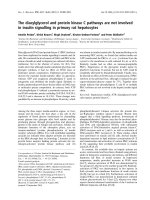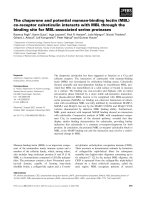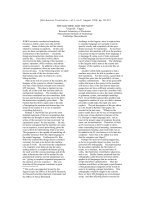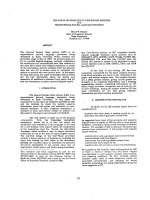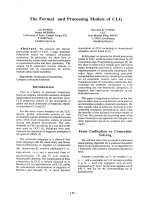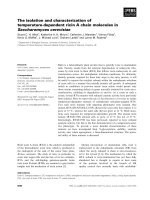Báo cáo khoa học: "The long and difficult road to better evaluation of outcomes of prolonged mechanical ventilation: not yet a highway to heave" pdf
Bạn đang xem bản rút gọn của tài liệu. Xem và tải ngay bản đầy đủ của tài liệu tại đây (32.81 KB, 2 trang )
Page 1 of 2
(page number not for citation purposes)
Available online />Abstract
The study conducted by Cox and coworkers included in this issue
of Critical Care demonstrates that prolonged mechanical ventila-
tion (MV; defined as MV for 21 days or longer) is more specific
than Diagnosis Related Group 541/542 as a marker of resource
utilization, hospital costs and potentially ineffective care. These
patients also had greater 1-year mortality and lower functional
ability than patients who had received MV for 48 to 96 hours,
despite having better baseline functional status. However, predic-
tors of mortality and long-term functional outcomes that are reliable
and accurate at the level of the individual patient remain to be
identified.
In this issue of Critical Care, Cox and coworkers [1] present
interesting information on the outcomes of patients receiving
prolonged mechanical ventilation (MV) in the intensive care
unit (ICU). A tremendous increase in need for ICU care and
associated expenditure is anticipated in the coming decades,
as the ‘baby boomer’ generation approach the age of
65 years [2]. This group of individuals is projected to
represent one in five (70 million) Americans by 2030. Beyond
this age the burden of acute and chronic illness rises
exponentially, as does the need for MV, which is an almost
absolute indication for ICU admission. In fact, the incidence
of MV during hospital admission has already increased
sharply. Data from the North Carolina Hospital Database [3]
indicate that, from 1996 to 2002, the number of patients
requiring MV grew from 284 to 314 per 100,000 North
Carolina residents. Notably, this 11% increase was
accompanied by significantly fewer discharges to home, more
discharges to nursing homes, and a greater burden of
comorbidity. Furthermore, compared with other ICU patients,
those on long-term MV consume a disproportionate amount
of critical care resources, in view of the small fraction of the
ICU population that they represent [4-8]. Therefore, to justify
these considerable financial costs, detailed evaluation of their
long-term outcomes is urgently needed.
Cox and coworkers [1] conducted secondary analyses of a
cohort of 817 adult patients who had received MV for 48
hours or longer at the University of Pittsburgh Medical Center
and who were followed up for 1 year. In the original study
report, Chelluri and coworkers [7] showed that only 44% of
these patients were alive 1 year after ICU admission, that
long-term mortality was significantly associated with older
age and poor pre-hospitalization functional status, and that
more than half of survivors at 1 year required care giver
assistance for basic daily activities. The primary objective of
the secondary analyses conducted by Cox and coworkers
was to compare health outcomes between two common
definitions of prolonged MV, namely MV for 21 days or longer
and MV for 96 hours or longer with placement of a
tracheostomy (Center for Medicare and Medicaid Services
Diagnosis Related Groups [DRGs] 541/542). A secondary
objective was to compare the outcomes of these outlier
patients with those of patients ventilated for shorter periods
of time (48 to 96 hours).
Heterogeneous definitions of prolonged MV exist in the
medical literature, but a uniform definition is essential in
analyzing epidemiological studies, interpreting benchmark
data, and guiding health care and reimbursement policies.
Although information based on DRGs are widely used
because they can be easily retrieved from large administrative
databases, a consensus conference recently recommended
that prolonged MV should be defined as need for at least 21
consecutive days of MV for at least 6 hours/day [9], because
the majority of MV-dependent patients transferred to long-term
acute care hospitals had received MV for at least 21 days.
Commentary
The long and difficult road to better evaluation of outcomes of
prolonged mechanical ventilation: not yet a highway to heaven
Alain Combes
1,2
1
Service de Réanimation Médicale, Hôpital Pitié-Salpêtrière, Assistance Publique-Hôpitaux de Paris, boulevard de l’Hôpital, 75651, Paris, France
2
Université Pierre et Marie Curie, Paris, France
Corresponding author: Alain Combes,
Published: 28 February 2007 Critical Care 2007, 11:120 (doi:10.1186/cc5701)
This article is online at />© 2007 BioMed Central Ltd
See related research by Cox et al., />DRG = Diagnosis Related Group; ICU = intensive care unit; MV = mechanical ventilation.
Page 2 of 2
(page number not for citation purposes)
Critical Care Vol 11 No 1 Combes
Several key messages emerge from the report by Cox and
coworkers [1]. First, prolonged MV defined as MV for at least
21 days is more specific than DRG 541/542 as a marker of
resource utilization and potentially ineffective care. These
patients had greater hospital costs and higher 1-year
mortality (58% versus 48%) than did patients with tracheos-
tomies who were ventilated for at least 96 hours. Costs per
1-year survivor after at least 21 days of MV were also
considerably higher (US$423,596 versus US$266,105). In
addition, the rate of potential ineffective care, which was
associated with age, male sex and number of pre-admission
dependencies in activities of living, was significantly higher
(41% versus 22%) for patients with MV duration of 21 days
or longer. Finally, survivors of both prolonged MV groups
reported lower functional capability than did patients who had
received MV for 48 to 96 hours, despite having better
baseline functional status.
Like previous reports [4-8], this descriptive series [1]
provides essential information regarding both short-term and
long-term outcomes after ICU care. However, several
important limitations are worth emphasizing. First, as in many
previous research studies in this field, the amount of data
missing because of death or inability to complete interviews
was considerable, although Cox and coworkers used
sophisticated statistical methods to alleviate any bias
resulting from this. These missing data might be responsible
for an underestimation of the true burden of disabilities
suffered by long-term MV survivors. Second, this study, once
again like many others evaluating the outcomes of critically ill
patients, does not offer predictors of mortality and functional
outcomes that are reliable and accurate at the level of the
individual patient. Such predictive models are eagerly awaited
because they might provide patients and their families with
reasonable expectations regarding outcomes; they may
provide ICU physicians with valuable help in making difficult
decisions regarding ICU admission, ICU discharge, or
limitation of care; and they might allow health care policy
makers and managers to allocate resources better.
Finally, many other opportunities for research ‘from bench to
bedside to administrative offices’ exist in the field, which
might ultimately lead to significant improvement in outcomes
of patients undergoing prolonged MV [9]. This research may
achieve the following: enhance our understanding of the
molecular mechanisms that underlie chronic illness myopathy
and of the impact of ageing on manifestations of chronic
illnesses; facilitate better definition and application of
weaning protocols, and nutritional and physical therapy
strategies; permit identification and correction of iatrogenic
factors that contribute to prolongation of MV; eliminate
financial or organizational incentives to delay patient
discharge; and promote development of a ‘pay for per-
formance’ heath care system, with adequate benchmarking
indicators for every institution providing prolonged MV.
Competing interests
The authors declare that they have no competing interests.
References
1. Cox CE, Carson SS, Hoff Lindquist JA, Olson MK, Govert JA,
Chelluri L: Differences in one-year health outcomes and
resource utilization by definition of prolonged mechanical
ventilation: a prospective cohort study. Crit Care 2007, 11:R9.
2. Angus DC, Kelley MA, Schmitz RJ, White A, Popovich J Jr: Caring
for the critically ill patient. Current and projected workforce
requirements for care of the critically ill and patients with pul-
monary disease: can we meet the requirements of an aging
population? JAMA 2000, 284:2762-2770.
3. Carson SS, Cox CE, Holmes GM, Howard A, Carey TS: The
changing epidemiology of mechanical ventilation: a popula-
tion-based study. J Intensive Care Med 2006, 21:173-182.
4. Combes A, Costa MA, Trouillet JL, Baudot J, Mokhtari M, Gibert
C, Chastre J: Morbidity, mortality, and quality-of-life outcomes
of patients requiring >=14 days of mechanical ventilation. Crit
Care Med 2003, 31:1373-1381.
5. Eddleston JM, White P, Guthrie E: Survival, morbidity, and
quality of life after discharge from intensive care. Crit Care
Med 2000, 28:2293-2299.
6. Chatila W, Kreimer DT, Criner GJ: Quality of life in survivors of
prolonged mechanical ventilatory support. Crit Care Med
2001, 29:737-742.
7. Chelluri L, Im KA, Belle SH, Schulz R, Rotondi AJ, Donahoe MP,
Sirio CA, Mendelsohn AB, Pinsky MR: Long-term mortality and
quality of life after prolonged mechanical ventilation. Crit Care
Med 2004, 32:61-69.
8. Esteban A, Anzueto A, Frutos F, Alia I, Brochard L, Stewart TE,
Benito S, Epstein SK, Apezteguia C, Nightingale P, Arroliga AC,
Tobin MJ: Characteristics and outcomes in adult patients
receiving mechanical ventilation: a 28-day international study.
JAMA 2002, 287:345-355.
9. MacIntyre NR, Epstein SK, Carson S, Scheinhorn D, Christopher
K, Muldoon S: Management of patients requiring prolonged
mechanical ventilation: report of a NAMDRC consensus con-
ference. Chest 2005, 128:3937-3954.


